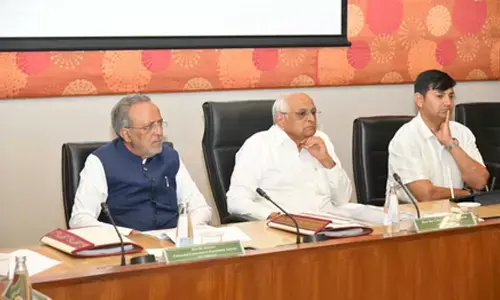The 70-year-old Indian Republic

‘A country does not become fit for democracy, it becomes fit through democracy’-noted economist and Nobel Laureate Amartya Sen’s words ring true for a country that chose to build a multi-party democracy after it was freed from the yoke of foreign rule. India stands apart singularly for its pluralism as it completes seven decades as a republic setting to rest doubts of naysayers over its survival. What has worked for this nation that chose to become a democratic republic with universal adult suffrage, which many said, was a fool hardy misadventure? What has kept it going ahead along its triumphs, trials and tribulations?
India, with its varied topography, extraordinary ethnic mix, 22 official and 780 spoken languages and diverse religions and culture has survived derisive remarks of the likes of Winston Churchill who lived in the delusion that the nation was no more than a "geographical expression." Whatever the political dispensation, however complex the social fabric, the nation has moved decisively on the path of progress overcoming existential threats and garnering attention as one of the world's most powerful democracies. Why did most countries consider India's choice of becoming a democratic republic with universal adult suffrage a fool hardy misadventure?
The skepticism of most leaders was based on the circumstances in which India became a free nation. The devastation caused by the deadly partition which claimed over a million lives, the unequal caste based hierarchical society steeped in poverty and an appalling illiteracy level of 84% were hardly great qualifications for a country beginning afresh. India took to democracy like a fish to water and the prophets of doom were silenced before long as the nation celebrated its differences and remained one says, Dr SY Qureshi former Chief Election Commissioner in an article on India's progress since it emerged as a nation. The celebrated writer, politician and winner of the Sahitya Akademi award winner for his book "Era of Darkness,' Shashi Tharoor, has an interesting explanation about the plurality and commonality of India. "If America is a melting pot, then to me India is a thali, a selection of sumptuous dishes in different bowls. Each tastes different and does not necessarily mix with the next, but they belong together on the same plate, and they complement each other in making the meal a satisfying repast" he avers.
The Republic day celebrates the coming to form of the Indian Constitution on 26th January 1950 replacing the Government India Act, 1935 as the governing document of India. Drafted over a period of 2 years, eleven months and 18 days and emerging as the longest written constitutions of the world it remains the most revered document for all Indians and is clearly dynamic with 103 amendments over the years. The years following independence were tumultuous involving intense activity which saw the integration of more than 500 princely states into the Indian Union. The political integration of India secured by Sardar Vallabh Bhai Patel set the tone for a strong and secular nation tottering towards self governance, and Jawaharlal Nehru, the first Prime Minster of India oversaw the country's transition from a colony to a republic with a multi-party system. The holding of the country's first general election under the Constitution in 1952 with a voter turnout of over 60% and an overwhelming win for the Congress remains the defining point of the first decade since India became a republic. The focus here was clearly on nation building and laying out a framework for the future. Formulation of five year plans, division of states on a linguistic basis (as opposed to four zones suggested by some leaders) and assuming a leading role in the Non Aligned Movement are major developments witnessed during this time.
The second decade witnessed politics and individual ambitions coming to the fore as Indira Gandhi cemented her position, the Congress party was split and there was a great deal of social upheaval. Ending privy purses for former Indian royalty, re-alignment of North Eastern states and the nationalization of banks are other major defining moments here.
The seventies saw the fruits of the green revolution begun in 1965 provide answers to the food crisis that stared at the nation with a significant rise in the yield of food crops. The use of high yielding variety of seeds, tractors, irrigation facilities and fertilizers was the product of intensive research and adoption of technology. Coupled with an increase in milk production courtesy the "Operation flood' scheme, India became self sufficient and ended two decades of food imports. However, the most tumultuous period in the history of the nation began towards the middle of this decade with the infamous emergency of 1975 posing the biggest ever threat to individual freedom and basic fundamental rights of guaranteed by the constitution. The nation- wide protests and strikes following the Allahabad High court judgement indicting Indira Gandhi for misusing political machinery during elections followed by the declaration of emergency where the centre had sweeping powers resulted in the suspension of civil liberties and dark days for democracy with 1000 leaders and activists across the country put behind bars. Emergency excesses resulted in a humiliating defeat for Indira Gandhi and the beginning of coalition governments in the country. It also brought about intense debates on the features incorporated in the Indian constitution.
The last four decades in the nations' history were a saga of triumph and tribulation, of sunny days and rainy ones, moments filled with optimism and those that were desolate and disheartening. We witnessed several cases of religious violence, casteism, naxalism, terrorism and regional separatist insurgencies time and again. Many movements seemed impossible to contain but they fell through. Many situations seemed to be the end of the road but new paths opened. Many wars have been fought and victories registered but the situation with our neighbours remains volatile. Since tension with our neighbours is an ongoing process, a huge chunk of our budget is allocated for defence each year. We lost two Prime Ministers to violent attacks, one killed by her own bodyguard and the other by a suicide bomber. The most significant development for the country however was in the nineties and it laid the foundation for the country's future. The neo-liberal economic reforms in 1991 that opened up new doors through liberalisation, privatization and globalization catapulted our country from a destitute country in the formative years to a fast-growing G 20 major economy today.
India has witnessed many revolutionary changes in seven decades as a republic. It would suffice to say that it has come a long way since it began. Many institutions have changed form. New states have emerged. New technologies and apps rule the roost and from celebrating the first Indian on space we have registered many space victories and are exploring moon missions undeterred by failure. We now speak of smart cities and indulge in verbal duels online. We have a young and expanding workforce, demanding citizenry, intense social media campaigns and a difficult neighbourhood. The last few years in particular have brought to the fore different views and protests, unrest at universities and restlessness among liberals, path breaking judgements and regressive attitudes. India's pluralism is evident from the many strikingly different social developments. We have more working women today but the freedom that Mahatma Gandhi foresaw for them is still a faraway dream. However, despite the many concerns that plague our society, the Indian republic has much to be proud of. Recalling our journey over the years is just another way to state that life can only be understood backwards but it must be lived forward.














